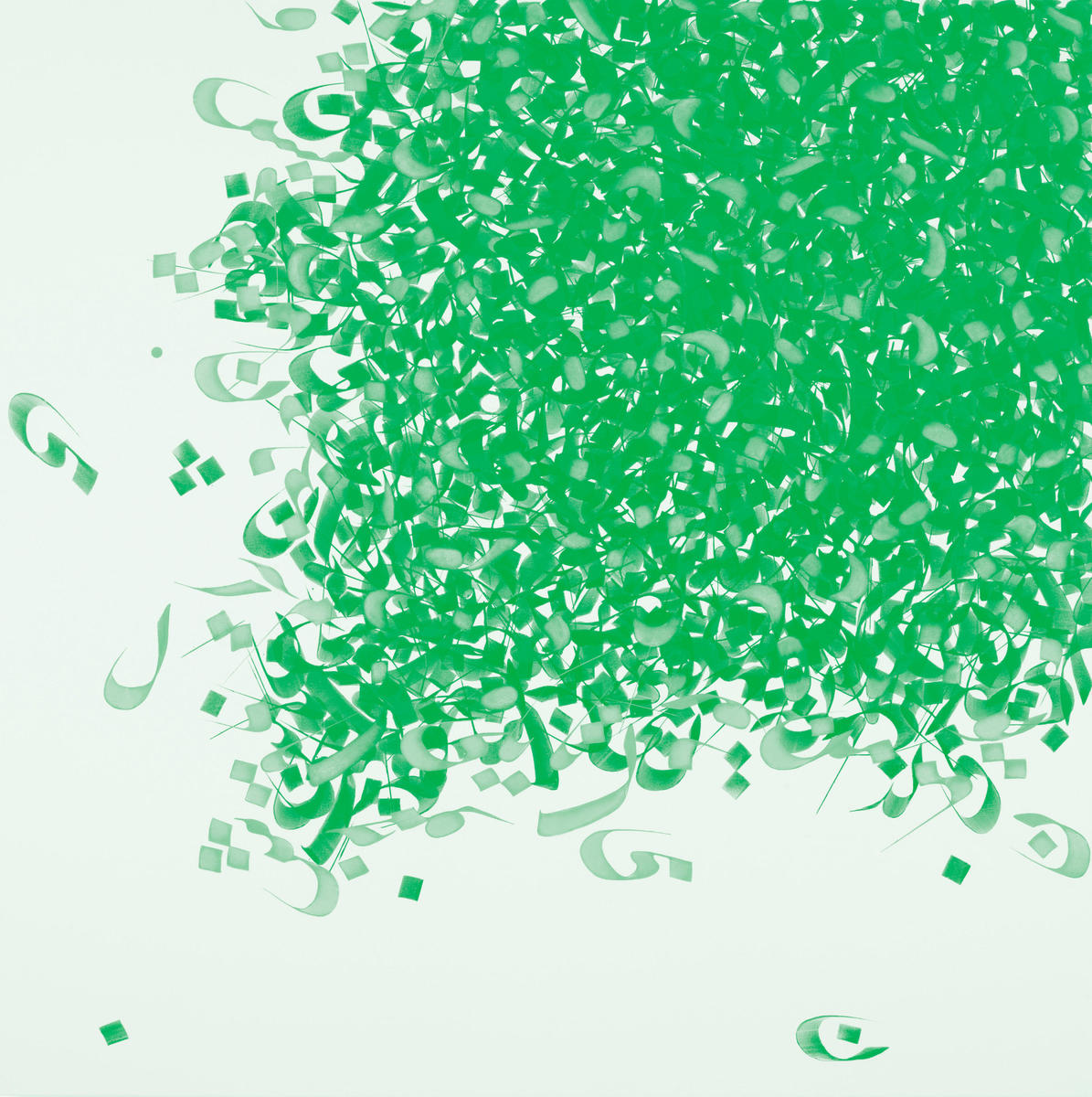
New York
Pouran Jinchi: Entropy
LTMH Gallery
November 17–December 23, 2010
The painter Pouran Jinchi’s recent show at Leila Taghinia-Milani Heller Gallery, ‘Entropy,’ deftly explored the delicate relationship between art and text. With ‘Entropy,’ Jinchi remains true to her distinctive approach to painting, a semiotic reversal in which she turns text into image. She likewise uses ink rather than paint on canvas, but allows the watery flat ink to pool and spread, presumably to give the medium a more painterly liveliness. Jinchi uses Farsi script, beautiful in its own right, as strokes, transforming otherwise legible but obscured words into gestural flourishes that are pilled on top of one another to create spiky masses that then suggest natural forms — fall leaves drifting down onto a raked pile, a whirlpool that could double as a black hole, or kissing nebulas floating through a void of space. In previous works, these natural forms were not only hinted at, but the script congealed to create, for example, clearly defined branches or trees. Here the forms taken by Jinchi’s “strokes” have a less defined character and likewise suggest less calming forms, like a pile of industrial debris or the dangerous detritus of sharp metal shavings.
While the use of Farsi script itself may be a loaded proposition, Jinchi avoids pointing to any potential political or symbolic suggestions that the words or script may offer. The words are sourced from the work of modern female poet Forough Farrokhzad and can be translated here and there (so I am told — I cannot read Farsi myself), but such a thwarted translation that offers up random vocabulary without grammar only reinforces the objective to look and sense. Jinchi studied traditional calligraphy as an old master might study drawing, seeking out mastery of technical skill as a means to reach a purity and fluidity of expression. The informative function of the words becomes form through the calligrapher’s technique.
In this way, Jinchi seeks to reconcile the traditional function of text as educational with its necessarily decorative and visual function within iconoclastic Muslim art, which traditionally does not otherwise allow for figurative religious imagery. In so doing, she connects the iconoclasm of Muslim art with the iconoclasm of high modernism and abstract expressionism in particular, in a soft postmodern gesture that is more concerned with art than geopolitics. But in subjugating text to image, Jinchi only appears to analyze text and language. In practice she never exposes any unseen cultural or political meaning. Rather, Jinchi delights in the construction of new forms, much as a proper modernist might.
Jinchi has previously engaged in more pointed commentary and imagery that is either political, as with Flag 5 (2002), an American flag made of Persian script and decorative motifs, or poetic, as with works like Derakht 11 (2001), in which Jinchi’s words create an oblivious bushy tree whose future autumnal waning is only hinted at by a few falling words/leaves. With her most recent exhibition, then, Jinchi distances herself from such legible or symbolic imagery. Even the title of her show, a hulking word like “entropy,” was left to the gallery to produce. As an artist who will in any case be persistently subject to stereotypical readings of anything Persian, political, or poetic, such a rebuff is more than understandable but nonetheless unfortunate.
If there is a problem with this show then it is that there is no problem. Despite their jagged forms, the content of the works is “soft.” These works are not fully intellectual nor sensual, political nor poetic, serious nor lighthearted. It is unclear whether her use of text functions as a modernist critique or as a celebration of the power of form, even beauty, over cognition and “reading.” The paintings are attractive, well done, and well conceived, but sometimes lack conceptual or formal focus. The meaning of the words used is consistently — and intriguingly — subverted, but so is the grace and fluidity of their form. Her palette of cool-as-can-be blues, greens, and blue-greens is likewise pervasive but apparently not meaningful, or at least not symbolic, but to my eyes also subverts the sensuality possible in the tangled calligraphic script. The shapes and forms also hint at a sense of humor. Words reach out for each other like hands, even yearning for contact, but are not truly funny. The liveliest moments in the canvases often come from Jinchi’s signature, which is hidden among the calligraphic melee in tidy block script, a neat touch.
Intellectual decisions, like the use of ink over paint, often water down the formalist power of the paintings, while formalist decisions, like the obfuscation of the text, water down the conceptual power of the works. Jinchi cleverly sees that the use of the gorgeous and simultaneously politically charged Farsi text has the power to offer at the same time conceptually and sensually satisfying works of art. This of course is no small feat, but Jinchi has tapped into a motif that offers such possibility that one senses that, given a louder voice, her words will have much more to say.